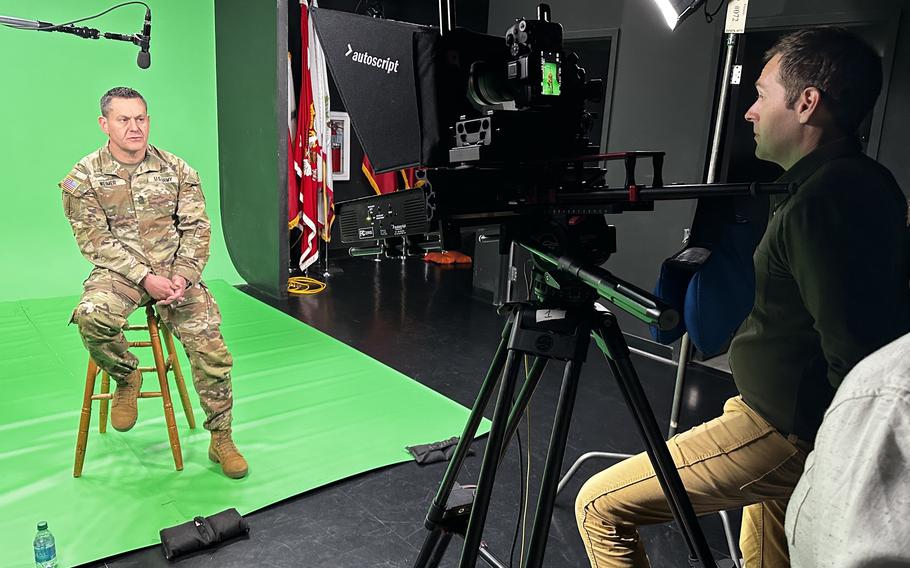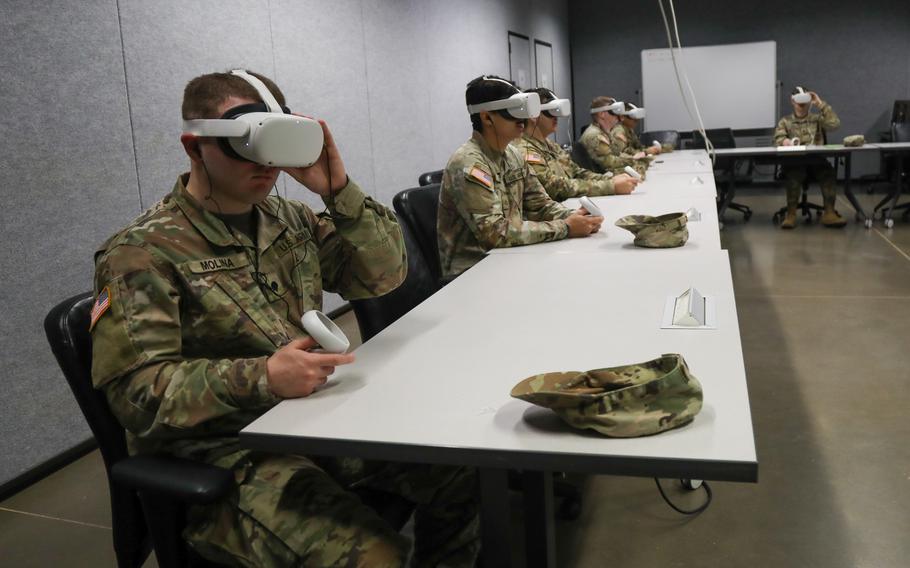
Sgt. Maj. of the Army Michael Weimer is filmed March 12, 2024, as a coach in virtual reality training on the topic of suicide prevention to be used by soldiers in Special Operations Command. (Daniel Wallace/U.S. Army)
Some Army units will soon offer troops suicide prevention training on virtual reality headsets that transport the soldier inside the home of a peer in crisis with Sgt. Maj. of the Army Michael Weimer coaching them through the scenario.
The experience is realistic and brings an “emotional edge” to the training, Weimer said during a recent interview about the technology that the Army began using last year to teach troops how to prevent sexual misconduct.
“To be honest, it makes you reflect,” he said of his own encounter with the VR training. “What were the missed opportunities I’ve had in my career?”
The military has struggled for years to tackle the crises of sexual assault and harassment and suicide deaths among service members.
Weimer, who has been on the job as the Army’s top enlisted soldier since August, said preventing these behaviors is a problem that keeps him up at night out of frustration over not having a greater impact.
“We’re charged with solving problems, and this is probably one of the toughest ones I’ve ever even been challenged with,” he said. “The goal is to not have a single suicide. The goal is to not have a single sexual assault. I mean, we know those goals, but when you’re talking [about] a million people, those are some really tough goals.”
The most recent Pentagon information available from fiscal 2023, which ended Sept. 30, showed 160 soldiers died by suicide. That is up 25 deaths from the previous year.
Yet a sexual assault report from the Pentagon released this month showed numbers dropped for the first time in nearly a decade. An estimated 29,000 service members experienced sexual assault — ranging from groping to rape — last year. That’s about 6,800 fewer than the previous year.
The Defense Department had launched independent reviews to examine each and find ways to overcome the problems. The groups that conducted the reviews have offered a series of recommendations for revamping the military’s approaches to fighting them. Some have been employed and credited with helping, others are years away from being implemented.
Weimer has tasked the Army’s senior noncommissioned officers to find creative solutions that might work in their units, which is what led some to try virtual reality, known commonly as VR.

Soldiers assigned to Fort Campbell, Ky., take part in virtual reality training on sexual harassment and assault prevention on Feb. 15, 2024. The VR program consisted of situational simulations in which soldiers tried to implement their training to help prevent sexual harassment and assault. (Caleb Pautz/U.S. Army)
Virtual reality is a powerful tool, but it’s not something that is practical to outfit for the entire Army or use as a replacement for traditional prevention training, Weimer said. However, it’s a compelling way to use technology with which young soldiers are likely familiar and drive home the lessons of those traditional prevention training programs.
Special Operations Command requested Weimer be the coach for the new suicide prevention training it recently acquired, and the scenarios the command receives will be focused on common stressors of the special operations community, where Weimer spent much of his career.
When soldiers put on the headset, it transports them into a cluttered room where a fellow soldier is clearly in distress. Scattered among family photos are empty bottles of alcohol and beer cans.
Capt. Josh Ecker of the 1st Special Forces Group said he put on the headset to test the training for the chaplains in his unit expecting to see something clearly animated.
“I was immediately surprised because I saw what looked like an actual service member with a full tattooed arm. He looked like someone I would find down the hall in my building,” he said. “We engaged in a conversation and the person basically let on that they’re feeling extremely stressed and hopeless.”
The soldier in the scenario recently made a mistake during training, and the person is convinced it will lead to a discharge. The soldier doesn’t feel like parents or family members had ever supported the person’s military career and describes feelings of failure and is clearly in distress.
Ecker said he could physically feel the stress of the situation as if he were actually in the room with the soldier. During his conversation with the soldier, the VR program provided three response options from which Ecker could choose. He had to say his chosen option aloud, which “felt way more effective to me,” he said.
However, none of the answers felt obvious.
“I think that’s partially because of the level of stress that you feel. Someone is about to hurt themselves, and your words can make the difference in them doing that or not,” Ecker said.
For Weimer’s role as the coach, Moth+Flame, the company behind the VR training, filmed him providing guidance and support based on the chosen response.
He’s there to remind troops of the Army’s prevention technique ACE, which means to ask, care and escort the person in crisis to safety. If the participant does not do these things, Weimer is there to deliver the news that the soldier in crisis did attempt to harm himself.
Weimer said he wants participants to walk away with a better sense of what to do if they are out in the real world and something similar plays out.
“I want them to feel more confident in being able to engage down at that battle-buddy level,” he said. “Call your leadership and then you don’t let your buddy out of your sight until the next level of leadership shows up to help you.”
The 82nd Airborne Division already uses 50 headsets purchased in October to train for sexual harassment and assault prevention, said Sgt. 1st Class Ashley Huiras, spokeswoman for the division. Headquartered at Fort Liberty, N.C., the division added suicide prevention scenarios this month, and 500 soldiers have taken part.
In the sexual misconduct prevention scenario, soldiers are transported into a meeting room with two men and a woman, said Spc. Michael Paustian, one of the unit’s nearly 1,500 soldiers who have experienced the training. The men are making hand gestures and saying things that are clearly making the woman uncomfortable, he said.
The program then asks the participant to make a choice on how to intervene using techniques taught in the Army’s sexual assault prevention courses. After speaking aloud the choice of intervention, the participant can see the rest of the scenario play out.
“If you chose to say something directly, it would show you what happened because of what you said. You get to see what you did and how it affected everything,” said Paustian, who had previous experience with VR through video games. “There’s no outside influences, and it feels very real. It’s sad to see somebody go through that but also you get to see what you do because of it.”
Huiras said she wishes she’d had an opportunity to go through this type of training earlier in her career. As a young sergeant, she said she saw someone with an energy drink that had a sexually explicit name. She said she walked by the soldier several times before working up the courage to ask him to remove it from his desk.
“It took me a long time to confront it, and once I did it was easier,” Huiras said. “I think the more practice you have just saying it is super helpful.”
Weimer said courage is difficult in any of these situations when a bystander must intervene. Training those muscles is the same as training for physical fitness, he said.
“This is an opportunity to improve scenario-based training with realism to get reps and sets, so when that moment pops up, that’s real, it’s less awkward,” he said. “I want them to feel more confident to engage down at that battle-buddy level.”